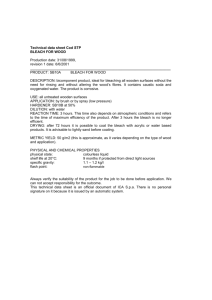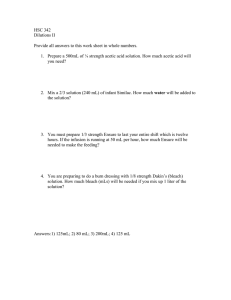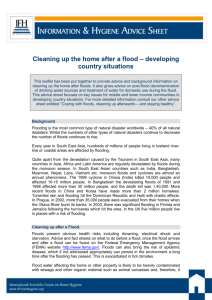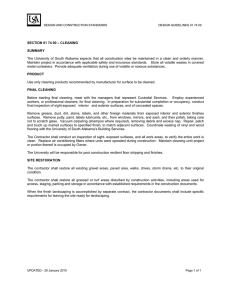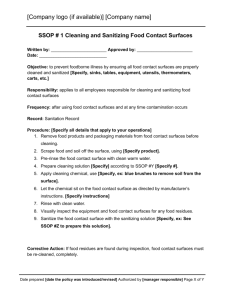Cleaning Up After a Flood
advertisement
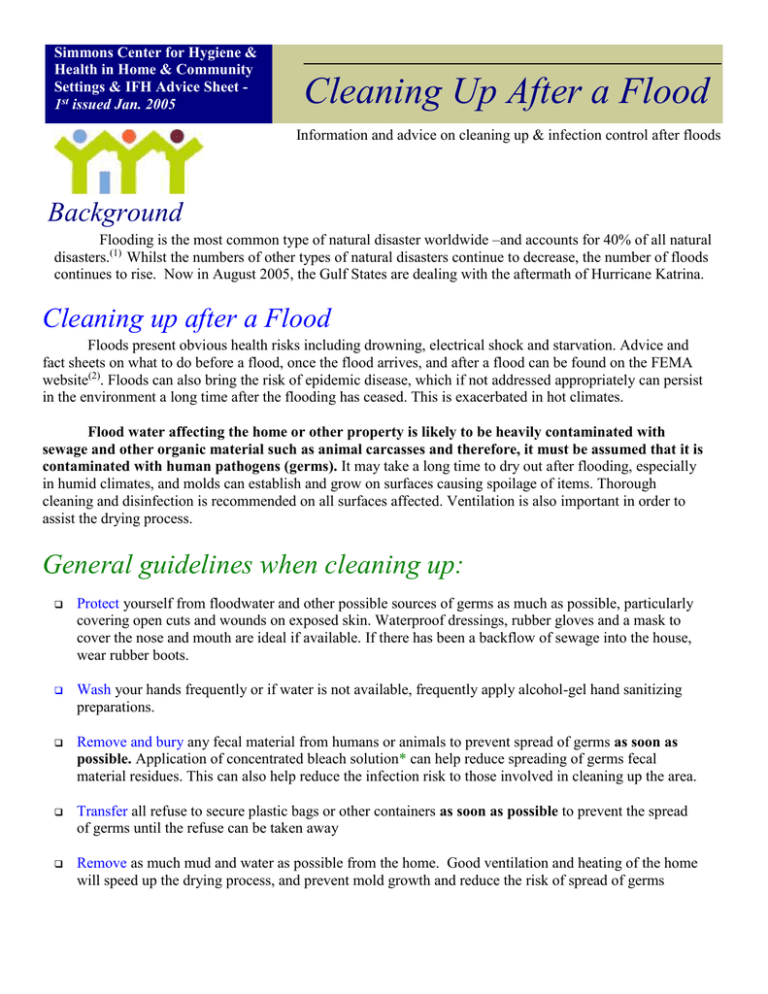
Simmons Center for Hygiene & Health in Home & Community Settings & IFH Advice Sheet 1st issued Jan. 2005 Cleaning Up After a Flood Information and advice on cleaning up & infection control after floods Background Flooding is the most common type of natural disaster worldwide –and accounts for 40% of all natural disasters.(1) Whilst the numbers of other types of natural disasters continue to decrease, the number of floods continues to rise. Now in August 2005, the Gulf States are dealing with the aftermath of Hurricane Katrina. Cleaning up after a Flood Floods present obvious health risks including drowning, electrical shock and starvation. Advice and fact sheets on what to do before a flood, once the flood arrives, and after a flood can be found on the FEMA website(2). Floods can also bring the risk of epidemic disease, which if not addressed appropriately can persist in the environment a long time after the flooding has ceased. This is exacerbated in hot climates. Flood water affecting the home or other property is likely to be heavily contaminated with sewage and other organic material such as animal carcasses and therefore, it must be assumed that it is contaminated with human pathogens (germs). It may take a long time to dry out after flooding, especially in humid climates, and molds can establish and grow on surfaces causing spoilage of items. Thorough cleaning and disinfection is recommended on all surfaces affected. Ventilation is also important in order to assist the drying process. General guidelines when cleaning up: Protect yourself from floodwater and other possible sources of germs as much as possible, particularly covering open cuts and wounds on exposed skin. Waterproof dressings, rubber gloves and a mask to cover the nose and mouth are ideal if available. If there has been a backflow of sewage into the house, wear rubber boots. Wash your hands frequently or if water is not available, frequently apply alcohol-gel hand sanitizing preparations. Remove and bury any fecal material from humans or animals to prevent spread of germs as soon as possible. Application of concentrated bleach solution* can help reduce spreading of germs fecal material residues. This can also help reduce the infection risk to those involved in cleaning up the area. Transfer all refuse to secure plastic bags or other containers as soon as possible to prevent the spread of germs until the refuse can be taken away Remove as much mud and water as possible from the home. Good ventilation and heating of the home will speed up the drying process, and prevent mold growth and reduce the risk of spread of germs Furnishings and fittings Remove and discard contaminated household materials such as soft furnishings and fittings that are damaged beyond repair e.g. wall hangings and floor rugs. For those items that cannot be washed or dry-cleaned such as mattresses or upholstered furniture, air dry them in the sun and then if there is no risk of color damage, spray them thoroughly with a solution of bleach. Steam clean all carpeting if possible. Bedding, clothing and other soft / fabric articles including children’s toys etc should be laundered according to IFH guidelines*** Hard Surfaces All hard surfaces should be hygienically cleaned either by cleaning followed by disinfection or by using a cleaner/disinfectant**. Be particularly careful to thoroughly disinfect surfaces that may come into contact with food, such as work surfaces, pantry shelves, refrigerators etc. Areas where small children play should also be carefully cleaned and disinfected with bleach. Allow all surfaces to dry thoroughly – good ventilation and heating will speed up the drying process. Mold For areas where mold has already begun to develop, a concentrated solution of bleach* may be used to kill the mold and remove the black mold stains. When the surface is visually clean, clean again with a fresh solution of bleach in order to kill any remaining non-visible mold spores. Allow all surfaces to dry thoroughly. Why Use Bleach? Page Bleach contains hypochlorite & acts very quickly (within 1 minute), but longer times are required for killing molds and fungi It is highly effective against viruses, bacteria, yeast and molds Bleach is an excellent “cleaner” for even the toughest soils, and for removal of mold growth Bear in mind that chlorine-based bleaches can damage and/or bleach fabrics, carpets and soft furnishings. It can also corrode metal surfaces 2 of 5 Food & Water Safety: Any item that comes into contact with food such as crockery, cutlery, utensils and cooking equipment MUST be “hygienically cleaned”** before re-use. If an adequate supply of hot water is available this can be done by detergent-based cleaning followed by thorough rinsing. Otherwise the items should be cleaned and then disinfected by soaking in a solution of bleach**. Do not be tempted to salvage foodstuffs. Any food item that has been in contact with floodwater should be regarded as contaminated and discarded. If it is not possible to reach shops, eat canned food provided that the can has not been punctured, corroded or damaged in any way and is not showing any signs of bulging or leakage. It is recommended to thoroughly clean and then disinfect the lid of the can with a solution of bleach to prevent any contaminants from entering into the contents on opening. If the contents of the can have an unpleasant odor or color or if the food looks mushy and the liquid cloudy, dispose of the can in a sealed plastic bag. NEVER even taste the food from cans that show any signs of spoilage in order to avoid the risk of botulism poisoning Never use untreated floodwater for drinking, food preparation (including infant formula) and cooking. Advice on treatment of water can be obtained from the WHO website: http://www.who.int/household_water/resources/en/emergencies.pdf Visit us at: www.simmons.edu/hygieneandhealth For more information: www.ifh-homehygiene.org Page 3 of 5 * Concentrated bleach In situations where concentrated bleach is required a solution containing not less than 4.5% or 45,000ppm available chlorine should be used **Hygienic cleaning of surfaces Since flood water affecting the home or other property is quite likely to be contaminated with sewage, animal feces, refuse etc. It is important that all surfaces are “hygienically cleaned” in order to get rid of germs as well as visible dirt. Hygienic cleaning of surfaces can be achieved in a number of ways according to the extent of the contamination and the facilities available: Clean using detergent (liquid or soap) and hot water. Detergent and hot water cleaning can be used to produce a hygienically clean surface provided that the surface is then thoroughly rinsed using clean (potable) running water. Mechanical action using a cloth, sponge or brush to maximize removal of soil and microbes is an important part of the process. Removal of soil by wiping with a cloth without subsequent rinsing is not considered sufficient to achieve a surface that is hygienic. Use of a contaminated cloth can actually spread pathogenic organisms onto previously uncontaminated hands and hand and food contact surfaces. Cleaning using soap or detergent and a disinfectant product. This process should be used on large surfaces which cannot be rinsed or for situations where an adequate supply of running water is not available If the surface is heavily soiled, clean thoroughly to remove the visible soil using a solution of detergent or soap. Using a clean cloth apply a solution of bleach, diluted to 0.5% or 5000ppm available chlorine, to the surface. Since disinfectants are inactivated to a greater or lesser extent by the presence of soil, heavily soiled surfaces MUST be cleaned before application of a disinfectant. If the surface is only “superficially“ dirty, it may be hygienically cleaned using a combined bleach/cleaner containing 0.5% or 5000ppm available chlorine. The solution should be applied with a clean cloth or via a spray bottle and the surface then wiped. If necessary repeat the process until the surface appears visibly clean. *** Hygienic cleaning of laundry Laundry can be made hygienically clean by: Washing at 104-140°F with a bleach-based product (check ingredients on the package), Washing at 140°F or above (using any product as the higher temperature kills germs). Washing at temperatures of 104°F or less without a bleach product is considered to carry a risk of inadequate decontamination for laundry. Page 4 of 5 Appendix: Useful sources of Information. a) On the IFH website For comprehensive guidelines on how, when, and where, hygiene should be applied in the home to prevent the spread of infectious disease: � Guidelines for prevention of infection and cross-infection in the domestic environment Focus on home hygiene issues in developing countries: http://www.ifhhomehygiene.org/2public/IFH-guidelines%202002_last.pdf � Recommendations for selection of suitable hygiene procedures for use in the domestic environment: http://www.ifh-homehygiene.org/2public/2pub04.htm b) On the Internet � Storm-Related Mortality by Center for Disease Control and Prevention (CDC). www.bt.cdc.gov/disasters/floods � FEMA Fact Sheet: Floods and Flash Floods www.fema.gov/hazards/floods � UNICEF water and sanitation in emergencies � http://www.unicef.org/wes/index_emergency.html � IRC water and Sanitation Resource Centre. Information and knowledge support on water sanitation and hygiene issues associated with flooding in developing country situations: http://www.irc.nl/page/15675 � For details on how to prepare and dilute chlorine solutions consult the WHO website http://www.who.int/household_water/resources/en/emergencies.pdf. References: 1. Storm-Related Mortality by Center for Disease Control and Prevention (CDC). www.bt.cdc.gov/disasters/floods 2. FEMA Fact Sheet: Floods and Flash Floods www.fema.gov/hazards/floods
